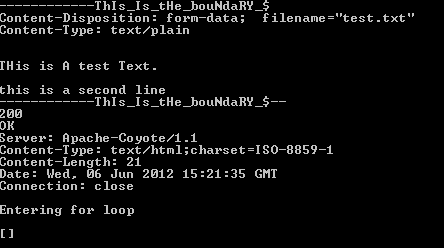Note: This is a server that is going to be used on a build farm, So 3rd party libraries are no use here.
I've been working on writing a python script that can be used to POST files on to a tomcat server (java), I finished writing the servlet and deployed it and to test its functionality I used cURL and the sever works fine , I was able to upload multiple files of various sizes , from 10mb to 1gb+, After that was done I started on the python module , I fairly new to python and this whole server thing , My python experience is about 2 weeks, so i'm still learning the tricks.
Here is the problem I'm facing , When I send the file to the server I receive a HTTP 200 , that means its successful , but the file is not in the uploads directory. My servlet accepts multipart/form-encoded data , so after some researching I managed to write one , I also use mmap to handle large file uploads.
After hours of looking at the code I decided to add in few print statements in the server so that I know whats happening , the uploading in the servlet takes place in a for loop , so when the program enters this loop I made it print out a message saying that its in the for loop , when I upload a file using curl I get this output , but when I use python I don't get anything
So here is my Python code , Keep im mind that I'm still learning this so there might be mistakes
import urllib2
import httplib
import sys
import os
import optparse
import mmap
import mimetools, mimetypes
def do_upload(options, args):
host = '127.0.0.1:80'
selector = '/test_server/upload'
url = 'http://127.0.0.1:80/test_server/upload'
if len(args) > 1:
print "invalid format"
path = args[0].replace("\\", "/").rsplit("/", 1)[0]
file = args[0].replace("\\", "/").rsplit("/", 1)[1]
print path
if not os.access(args[0], os.F_OK):
print "Directory Doesn't exist"
exit(1)
os.chdir(path)
f = open(file)
content_type, body = encode_multipart_formdata([file])
h = httplib.HTTP(host)
h.putrequest('POST', selector)
h.putheader('content-type', content_type)
h.putheader('content-length', str(len(body)))
h.endheaders()
h.send(body)
errcode, errmsg, headers = h.getreply()
print errcode
print errmsg
print headers
for l in h.getfile():
print l
return h.file.read()
f = open(file, 'rb')
sys.stdout.write(f.read())
mmapped_file_as_string = mmap.mmap(f.fileno(), 0, access=mmap.ACCESS_READ)
request = urllib2.Request(url, mmapped_file_as_string)
request.add_header('Content-Type', content_type)
response = urllib2.urlopen(request)
mmapped_file_as_string.close()
f.close()
def encode_multipart_formdata(files):
BOUNDARY = '----------ThIs_Is_tHe_bouNdaRY_$'
CRLF = '\r\n'
L = []
for (filename) in files:
L.append('--' + BOUNDARY)
L.append('Content-Disposition: form-data; filename="%s"' % (filename))
L.append('Content-Type: %s' % get_content_type(filename))
L.append('')
#L.append(value)
L.append('')
content = ""
for line in open(filename, 'rb'):
content += line
L.append(content)
L.append('--' + BOUNDARY + '--')
body = CRLF.join(L)
print body
content_type = 'multipart/form-data; boundary=%s' % BOUNDARY
return content_type, body
def get_content_type(filename):
return mimetypes.guess_type(filename)[0] or 'application/octet-stream'
I'm also including some console screenshot and Wireshark results.
This is the console output after runing the cURL
this is the output from My program
As you can see the python stops at "Entering for loop" and the empty brackets should contain the parts converted to string like in the cURL console
My initial doubt was the encoding , the servlet expects a multipart-form/data, so I used to wireshark to check this and here are the results.
Wireshark of cURL
Wireshark of my program
As you can see they both look similar. except cURL uses HTTP/1.1 and my python uses HTTP/1.0, not sure why that is happening.
So if anyone can guide me in the right direction I'd be more than happy and I hope I have provided enough information , if anyone wants me to post the servlet code I shall do that on request.




